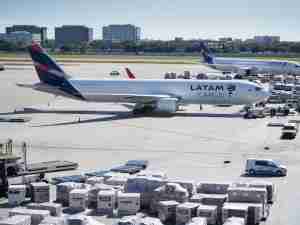Global air cargo tonnages have rebounded in the final full week of February following their normal Lunar New Year (LNY) dip, while key Asia-Europe sea-air hubs have continued to record a strong surge in tonnages, linked to the disruptions to container shipping in the Red Sea, analysis this week by WorldACD Market Data reveals.
As highlighted last week, Asia-Europe sea-air hubs such as Dubai, Colombo and Bangkok have in recent weeks experienced exceptionally high air cargo demand, as cargo owners whose supply chains have been disrupted by the attacks on container shipping in the Red Sea seek fast but affordable alternatives to deliver goods to Europe from Asia Pacific. Fresh analysis this week, based on the more than 450,000 weekly transactions covered by WorldACD’s data, reveals that Dubai-Europe air cargo traffic in week 8 was at more than double (+146%) its level this time last year, with average tonnages for the last two full weeks (weeks 7 and 8) up by +140%, year on year (YoY).
Meanwhile, Colombo-Europe tonnages were up by more than +80%, year on year (YoY), in weeks 7 and 8. Although Colombo-Europe air cargo traffic has been on the rise since August 2023, after declining in the first half of last year, the increases have been significantly stronger since December (+46%), rising to +60% in January and increasing further to around +80%, YoY, in the last three weeks. Bangkok-Europe volumes have been up, YoY, by at least +40% during each of the first seven weeks of this year, although that eased to +15% in week 8, suggesting a possible moderating of demand on that lane.
It remains to be seen to what extent the recent spikes in demand through these Asia-Europe sea-air hubs have been driven or boosted by LNY, which fell this year on 10 February, and whether the continuing strong demand via Dubai and Colombo will be sustained into March. But that demand showed no signs of waning in week 8.
These strong volumes helped total worldwide air cargo tonnages to record a +9% week-on-week (WoW) rise in week 8 (19 to 25 February) after dropping, WoW, by -10% in each of the two previous weeks, although the rise in week 8 will be mainly the result of tonnages recovering following the usual drop during the LNY holiday week. Average worldwide rates eased upwards by around 2% in week 8 after dipping by around 8% in week 7.
Two week comparisons
Expanding the comparison period to two weeks reveals a complex picture, with demand affected by various factors including LNY on 10 February and the annual surge in demand for flower shipments ahead of Valentine’s Day on 14 February, in addition to the effects of the Red Sea container shipping disruptions. Overall global tonnages in weeks 7 and 8 combined were down by -11% compared with the previous two weeks (2Wo2W), with big drops from origin regions Asia Pacific (-24%) and ex-Central & South America (-25%), reflecting those LNY and Valentine’s Day factors, respectively. Tonnages from Africa were down -8%, and ex-North America -1%, while origin region Europe recorded a +3% increase, on a 2Wo2W basis. But the standout origin region was Middle East & South Asia, which like last week was the only origin region to show a significant rise (+11%) in average tonnages (+7%) and rates (+13%).
Average rates from all the other main origin regions were either flat (Europe and North America) or declining, 2Wo2W, with small drops ex-Africa (-3%) and ex-Central & South America (-4%), while average prices ex-Asia Pacific sank by -11%. That price drop ex-Asia Pacific, and the big drop in tonnages from the high-yield Asia Pacific outbound market, were the main factors pushing down overall global average prices in those two weeks by -6%, 2Wo2W, despite the price rise ex-Middle East & South Asia.
Looking at the various big international air cargo corridors, Middle East & South Asia to Europe was the only major intercontinental lane to show a significant rise in average prices (+19%) – most likely a reflection of the surge in recent weeks of Asia Pacific to Europe traffic converted to sea-air – with tonnages on that lane also rising significantly (+14%). But most other lanes recorded 2Wo2W declines consistent with the after-effects of LNY and Valentine’s Day. Ex-Asia Pacific tonnages to Europe, North America and Middle East & South Asia were down by -29%, -28% and -33%, respectively, while northbound tonnages from Central & South America to North America fell by -34%, 2Wo2W, with a -11% drop in average prices. Africa to Europe tonnages were also down significantly (-9%), while intra-Asia Pacific volumes recorded a -10% decline, 2Wo2W – having fallen steeply in the run-up to and following LNY.
Year-on-year perspective
Year-on-year (YoY) comparisons show a -4% decrease in total worldwide tonnages for weeks 7 and 8, combined, compared with last year, driven downwards by a -11% drop ex-Asia Pacific and partially offset by a +27% increase ex-Middle East & South Asia.
Price-wise, average yields rates of US$2.25 per kilo in week 8 are -18% below their levels this time last year, with rates ex-Europe and ex-North America down by -31% and -21%, respectively, and prices ex-Asia down by -14%, while rates ex-Middle East & South Asia are up by +9%, YoY. Nevertheless, average global rates remain significantly above pre-Covid levels (+26% compared to February 2019).
Overall worldwide air cargo capacity remains significantly up on last year’s levels (+8%).









